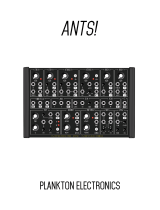Page is loading ...

v2.3

2
TELEPLEXER
Limited Warranty ----------------------------------------------------3
Installation --------------------------------------------------4
Overview ---------------------------------------------------5
Panel Controls -----------------------------------------6
Source Cables ----------------------------------------------8
Patch Ideas -----------------------------------------------------9

Limited WARRANTY:
THANK YOU
Design Assistant: Matthew Sherwood
Beta Analysts: Walker Farrell, Joe Moresi, Pete Speer
Test Subjects: Richard Devine, Surachai
About This Manual:
Written by Tony Rolando
Edited by Walker Farrell
Illustrated by W.Lee Coleman
Make Noise warrants this product to be free of defects in materials or construction for a period of one year
from the date of purchase (proof of purchase/invoice required).
Malfunction resulting from wrong power supply voltages, backwards or reversed eurorack bus board cable
connection, abuse of the product, removing knobs, changing face plates, or any other causes determined by
Make Noise to be the fault of the user are not covered by this warranty, and normal service rates will apply.
During the warranty period, any defective products will be repaired or replaced, at the option of Make Noise,
on a return-to-Make Noise basis with the customer paying the transit cost to Make Noise.
Make Noise implies and accepts no responsibility for harm to person or apparatus caused through operation
of this product.
Please contact [email protected] with any questions, Return To Manufacturer Authorization,
or any needs & comments.
http://www.makenoisemusic.com
3

Electrocution hazard!
bus board connection cable.
Do not touch any electrical terminals when attaching any Eurorack bus board cable.
The Make Noise TELEPLEXER is an electronic music module requiring 20mA of +12VDC and 20 mA of -12VDC
regulated voltages and a properly formatted distribution receptacle to operate. It must be properly installed
into a Eurorack format modular synthesizer system case.
Go to http://www.makenoisemusic.com/ for examples of Eurorack Systems and Cases.
board connector cable on backside of module (see picture below), plug the bus board connector cable into
the Eurorack style bus board, minding the polarity so that the RED stripe on the cable is oriented to the
NEGATIVE 12 Volt line on both the module and the bus board. On the Make Noise 6U or 3U Busboard, the
negative 12 Volt line is indicated by the white stripe.
supply.
-12V
4

Overview:
The Teleplexer is a telegraph style multiplexer.
You likely know what a telegraph is, but have you considered the musical value of the telegraph? As the building blocks of
synthesis are a by-product of communications technologies, why not look to telegraphy for inspiration? The speed and agility
telegraph operators displayed relaying life-altering messages across the world was staggering toward some form of future
musical genius.
In musical applications a multiplexer is type of signal router. It allows for any one of several signal inputs to be routed to a single
signal output. It is useful for switching quickly between multiple modulation or audio sources in a patch.
The Teleplexer applies the fast, physically immediate techniques of telegraphy to playing the modular synthesizer. The user
patches any number of Source Cables and then touches them to the surface of the Teleplexer to create patch connection. The
user determines the destination(s) and polarity of signal by touching the Source Cable to any one of the 14 metal plates.
The Teleplexer is designed to inspire you to explore modulation schemes, spontaneous timbral shifts and to be physically
involved with the modulation process. Although the primary purpose of the Teleplexer is to allow for complex, momentary
modulations, it may also be used for jumbling multiple audio signals together at the whim of the user or creating polyrhythmic
timing variations.
Do not use signals from outside the modular system where the TELEPLEXER is installed. Your TELEPLEXER faceplate will
become worn with use. This is OK and will not have any eect on the functionality of the TELEPLEXER. Just keep the faceplate
clean using a soft, dry cloth.
You’ve done some patchin’- now it is time to do some teleplexin’...
5

1 3
4
6
2
8
5
9
7
1
2
3
1+2
1+3
20
2+3
1+3
1+22+3
13
1+2+3
1+2+3
2
10 11
12
13 14
15
16
10
17
18
19 20
21 22
23
Teleplexer Interface
1. Aux. Input CH. 1: direct coupled signal input, continuously added to CH. 1
2. Aux. Input CH. 2: direct coupled signal input, continuously added to CH. 2
3. Aux. Input CH. 3: direct coupled signal input, continuously added to CH. 3
4. Output CH. 1: direct coupled signal output for CH. 1
5. Output CH. 2: direct coupled signal output for CH. 2
6. Output CH. 3: direct coupled signal output for CH. 3
7. CH. 1 Signal Indication: channel number lights to show level and polarity of signal. Green is positive signal and red is negative
signal.
8. CH. 2 Signal Indication: channel number lights to show level and polarity of signal. Green is positive signal and red is negative
signal.
9. CH. 3 Signal Indication: channel number lights to show level and polarity of signal. Green is positive signal and red is negative
signal.
6

Output Channel Routing
10. Plate (+1): sends signal to output 1, non-inverted
11. Plate (+2): sends signal to output 2, non-inverted
12. Plate (+3): sends signal to output 3, non-inverted
13. Plate (+1) + (+2): sends signal to outputs 1 and 2, non-inverted
14. Plate (+2) + (+3): sends signal to outputs 2 and 3, non-inverted
15. Plate (+1) + (+3): sends signal to outputs 1 and 3, non-inverted
16. Plate (+1) + (+2) + (+3): sends signal to all outputs, non-inverted
17. Plate (-1) + (-2) + (-3): sends signal to all outputs, inverted
18. Plate (-1) + (-3): sends signal to outputs 1 and 3, inverted
19. Plate (-1) + (-2): sends signal to outputs 1 and 2, inverted
20. Plate (-2) + (-3): sends signal to outputs 2 and 3, inverted
21. Plate (-1): sends signal to output 1, inverted
22. Plate (-2): sends signal to output 2, inverted
23. Plate (-3): sends signal to output 3, inverted
1 3
4
6
2
8
5
9
7
1
2
3
1+2
1+3
20
2+3
1+3
1+22+3
13
1+2+3
1+2+3
2
10 11
12
13 14
15
16
10
17
18
19 20
21 22
23
7

Source Cables
These are cables where one end of the cable is patched to the output of a signal generator/ processor in the modular system and
the other end is not patched. The tip of the Source cable is touched to the surface of the TELEPLEXER at the location and time of
the desired patch connection. When the tip of the source cable is removed from the surface of the TELEPLEXER, the patch
connection is broken and ended. Possible sources include LFO, Envelope, Sequence, Random Voltage, Clock, Gate, Pulse, Audio
Signals and more. As long as the signal is generated within the modular system in which the TELEPLEXER is installed, it is OK to
use. It is not OK to use signals from outside the modular system where the TELEPLEXER is installed.
Auxiliary Ins
We included one unity gain Aux Input per channel on the TELEPLEXER. These inputs are useful when you have a signal source that
you would like to run continuously to the destination or where you would like to control the signal level/routing elsewhere in the
patch using a VCA or Voltage Control Switch, for example. The plates allow you to add (using the non-inverting plates) or subtract
(using the inverting plates) signals from the signal patched to the Aux Input.
For example, you might want to sequence the Fold parameter, and then add and subtract 2 dierent LFOs from the sequence. To
do this, you would patch the Sequence to the Aux Input, the Output to the Fold CV Input, and the patch Source Cables to CH. 1
and CH. 4 of MATHS programmed for some type of LFO. Using the attenuvertors on MATHS, you could set the desired modulation
depth while using the TELEPLEXER to momentarily add or subtract the LFOs from the sequence.
OUTs
The outputs of the TELEPLXER are to be patched to your desired destinations. Each of the 3 outputs is capable of driving multiple
destinations, so buered multiple is not needed. Each output has LED indication of channel number (1, 2 or 3), signal polarity
(Green is Positive, Red is Negative) and signal level (stronger signals are brighter). Just about any input within the modular system
will work as a destination. It is possible to route Control Voltages (LFOs, Envelopes, Sequences, Random Voltages), Audio Signals
(VCO Waveform outputs, signal processor outputs), and Timing signals (Clocks, Gates, Pulses); however, it is generally not desirable
to mix these signals. For example, an audio signal is not useful when patched to a timing destination. Therefore, it is a good idea
to teleplex control voltages OR timing events OR audio signals.
The PLATES
The metal plates on the face of the TELEPLEXER are how the user communicates with the module. Touching the tip of a Source
Cable to these plates allows user to create connections in a patch. The result is everything from momentary modulations to
sustained timbral shifts to complete jumbling of signal path. It is possible to use as many sources as desired- only your available
patch cables are the limit. Sources should only come from within the system where the TELEPLEXER is installed.
The 14 plates cover every possible combination of signal routing to the 3 outputs. Inverted routes are included as well, making it
possible to both add & subtract voltages by using several sources at multiple plates. For example, touch Source Cable 1 to Plate
(+1) and Source Cable 2 to Plate (-1) and you are subtracting these to signals with the result appearing at OUT 1. If you were to
touch Source Cable 1 to Plate (+1) + (+2) and Source Cable 2 to Plate (+2), you would be adding these to signals- the result
appearing at OUT 2. Additionally, Source Cable 1 would appear at OUT 1.
8

9
Patch Ideas:
TELE-Speed Scratch
Patch an Oset such as Channel 2 of MATHS to the Aux 1 Input of the TELEPLEXER. Patch from its associated output to the
Vari-Speed Input on the Morphagene or Phonogene with the attenverter full clockwise. Use the Morphagene’s Vari-Speed
Activity Windows to nd the desired Vari-Speed setting with the MATHS Ch. 2 attenuator. Using another Oset, patch to the
bottom three plates of the TELEPLEXER to momentarily subtract from the voltage driving the playback speed and direction of the
Morphagene.
Momentary Eects
Patch a sound source, such as the MORPHAGENE and leave the cable hanging as a dummy cable. Now, patch from the Channel
Outputs of the TELEPLEXER to the signal inputs of two or more eects processors, such as the ERBE-VERB and ECHOPHON, with
the Wet/Dry controls set to mostly wet. Use the cable from the MORPHAGENE to momentarily route signal to the eects. Mix and
monitor to taste.
/











